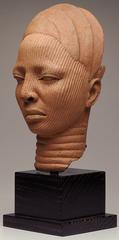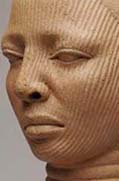
 |
This nearly life-sized head probably represents a member of the
royal court of Ife. She wears her hair in several ridges, a style
that proclaims her high status. The delicate vertical lines that cover
her face represent a pattern of SCARIFICATION.
Like tattooing, cutting patterns into the skin is a way of marking
a person's identity or status. The patterns are also considered beautiful
and enjoyable to touch. Scarification was widely practiced in West
Africa until recently, and it is still a part of young girl's initiation
into adulthood among some groups. |
|
|

Key ideas.
Where does it come from?
What does it look like?
How was it used?
How was it made?
How big is it?
Who Knows?
Additional resources.
 Great
care has been taken in shaping this face to create the convincing
illusion of human flesh and its underlying muscles and bone structure.
Great
care has been taken in shaping this face to create the convincing
illusion of human flesh and its underlying muscles and bone structure.